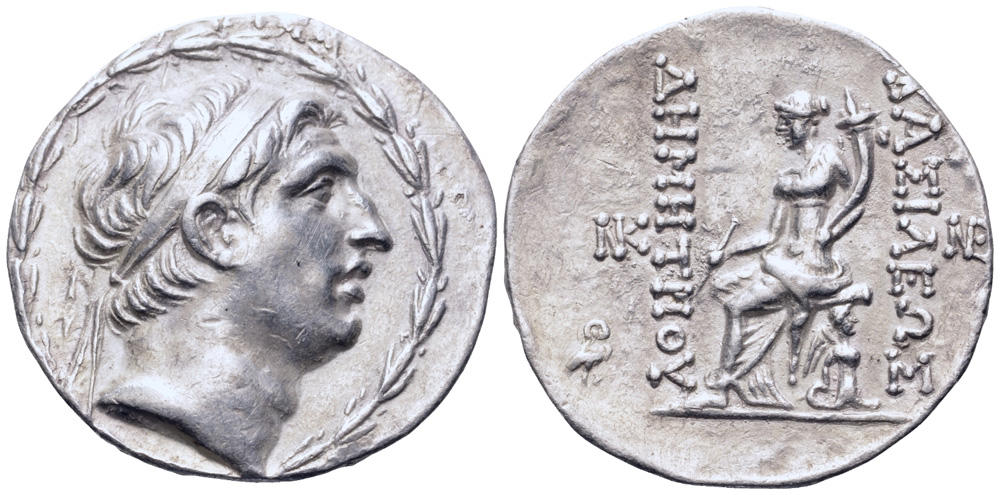Soli (Demetrius I), silver, tetradrachms (162-150 BCE)
From SILVER
162 BCE - 150 BCE Silver 854 kg
Description
| ObverseInscription or printing placed on the obverse.: | Diademed head right |
| ReverseInscription or printing placed on the reverse.: | ΒΑΣΙΛΕΩΣ ΔΗΜΗΤΡΙΟΥ (Greek).Tyche seated left on throne supported by Nike, NK monogram in outer right field, owl standing right in lower left field |
Mint and issuing power
| MintIdentifies the place of manufacture or issue of a numismatic object.: | Soli-Pompeiopolis (Cilicia) | Ancient regionAncient region.: | Cilicia | Modern countryModern country: Turkey | AuthorityIdentifies the issuing power. The authority can be "pretended" when the name or the portrait of X is on the coin but he/she was not the issuing power. It can also be "uncertain" when there is no mention of X on the coin but he/she was the issuing power according to the historical sources: | Demetrius I Soter (Seleucid king, 162-150 BC), Seleucid Dynasty (312-63 BC) |
Chronology
| FromIdentifies the initial date in a range assigned in a numismatic context. | 162 BCE | toIdentifies the final date in a range assigned in a numismatic context.. | 150 BCE | PeriodTime period of the numismatic object.: Hellenistic 323-30 BC |
Physical description
| MetalThe physical material (usually metal) from which an object is made.: | Silver |
Median weightMedian of the weights of numismatic objects (in grams). in grams | 16.75 | DenominationTerm indicating the value of a numismatic object. Examples: tetradrachm, chalkous, denarius.: | tetradrachm |
StandardStandard.: | Attic |
Image

H294 Soli Demetrius I tetradrachms.jpg [1]
References
| Die study referencePublication of the study: | Houghton 19891Houghton 1989, p. 26-27 | ||
| Coin series referenceReference to coin series study: | RQEMH2RQEMH, n° 295, SC II3SC II, n° 1611, HGC 94HGC 9,n° 795 | ||
Obverse dies distribution
| FrequencyFrequency of specimen in distribution. ᵖ | Number of obversesNumber of obverse dies. ᵖ (o) | % (o) | Number of coinsNumber of coins. (n) | % (n) | Die nameName(s) of the die(s). |
| 2 | 1 | 50 | 2 | 33.33 | 1 |
| 4 | 1 | 50 | 4 | 66.67 | 2 |
| Total | 2 of 2 | 100 | 6 of 6 | 100 |
Reverse dies distribution
no distribution is available
Quantification
| Number of obversesNumber of obverse dies. ᵖ (o) | 2 | Number of singletons (o1)The number of singleton coins. ᵖ | |
| Number of reverse diesNumber of reverse dies. (r) | 4 | Number of coinsNumber of coins. (n) | 6 |
| Coins per obverse dieNumber of coins per obverse die. (n/o) | 3 | Coins per reverse dieNumber of coins per reverse die. (n/r) | 1.5 |
| Reverse per obverse ratioRatio of obverse dies divided by reverse dies. (r/o) | 2 | Percentage of singletons (o1)number of coins (n) divided by the number of singletons (o1) ᵖ | % |
| Original number of dies (O) (Carter 1983 formula)The estimation of the number of coins according to Carter 1983 ᵖ | 2.55 | Coins struck if 20,000 as average productivity per dieCoins made if the average productivity for obverses (according to Carter) is 20,000. ᵖ | 51,000 |
| Original number of dies (O) (Esty 2011 formula)The estimation of the number of coins according to the singleton formula in Esty 2011 ᵖ (O) | 3 | Survival rate if 20,000 as average productivity per dieSurvival rate if average productivity is 20,000. ᵖ | 0.00012 |
| Coverage (o = % of O) (Esty 1984 formula)Esty 1984 - coverage (% of O) ᵖ (o = % of O) | % | Die productivity if survival rate 1/2,000Average productivity if survival rate is 1/2,000. ᵖ | 4,705.88 |
| Weight of silver (in kg) if 20,000 coins per die (O = Carter formula)Carter 1983 * Median weight * 20000 (*10 if gold or electrum) ᵖ | 854 kg <br /> 854 kg | Die productivity if survival rate 1/5,000Average productivity if survival rate is 1/5,000. ᵖ | 11,764.71 |
Remarks
Most likely one single workstation